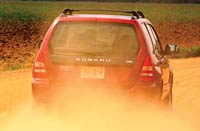Sunday, July 28, 2013
Reviews SUV Used Car Reviews

2003-2005 Subaru Forester
If it seems funny that Subaru had us test its 2003 Forester at Alabamas Talladega Superspeedway, trust me, it was. By the third time Id steered the second generation of this car-based SUV through the 2.66-mile ovals 33-degree high banks, I was grinning. By the end of my co-drivers turn at the wheel, I was laughing nonstop, so unlikely was the scene of this sensible Subaru all-wheel-driving at 85 mph over the same pocked tarmac where NASCAR stockers rub fenders at nearly 200.
I couldnt help thinking that we should have driven the new Forester on the steep ascents of San Francisco, the better to test the famous Hill-Holder clutch, which returns in the Forester after a five-year absence from the Subaru lineup. (The food would have been better in Frisco, too.) The Hill-Holder, standard with the five-speed manual, engages a pressure-holding valve when both clutch and brake pedals are depressed. Let up on the brake, and in that brief moment when your right foot is moving toward the accelerator pedal, when normally the car might roll backward toward Fishermans Wharf, the brakes stay locked until your hoof actually makes contact with the go pedal.
But we were not in San Francisco, and we do like Alabama barbecue, just as weve liked the Forester since it debuted five years ago as one of the first crossover vehicles. For 2003, changes to the wackiest Subaru are not revolutionary, but theyre noteworthy. The sheetmetal is new, with raised-eyebrow headlights and a hexagonal tailgate framing the more muscular bodywork. The stiffer chassis, derived from the new Impreza, boasts a front subframe made of hydroformed steel members.
Bigger anti-roll bars and front brakes have been fitted, and the interior has been freshened. Subarus 165-horsepower, 2.5-liter boxer four returns. You were expecting the Impreza WRXs turbo four? Dream on--the Forester is practical, not fantastical. Besides, that scenario would substantially raise the Foresters tariff, currently in the low to mid-$20,000s, and Subaru hopes to hold the line on Forester pricing, maybe even to drop it a bit on a comparably equipped basis.
The Forester has never beckoned to hot-footers, anyway, or to those people for whom all consumer goods, whether they be houses, fountain drinks, or SUVs, are better if theyre bigger. Its appeal lies in its standard all-wheel drive; modest yet functional overall size; just-right seating position--not too high, not too low, offering superb all-around visibility; useful 7.5 inches of ground clearance; and reasonable cargo capacity. If you haul around all your worldly goods, skip this one. But if you leave most of them at home, the Foresters 32.0 cubic feet of cargo space with the rear seats in place and 64.1 with them folded will serve you well. My co-driver and I hauled a seven-foot, 200-year-old grandfather clock from a rural antiques store to our Birmingham hotel (albeit with one of us riding beside it in the back seat).
The Foresters carryover strut-type four-wheel independent suspension does a decent job of damping most under-wheel intrusions, except in the truck lanes of Alabamas freeways, which can test the mettle of any cars underpinnings. Under those circumstances, we found it best to move into the left lane and give the Forester the boot. Said maneuver demonstrated that the optional four-speed automatic is hard-pressed to make the most of the engines modest torque. Go for the five-speed manual.
Side air bags, now protecting both head and chest rather than just chest, are newly standard, along with front-seatbelt pretensioners and active head restraints, and the uplevel XS model gets electronic brake-force distribution. Perhaps most interesting, though, is not what has been added but what has been taken away: weight. The Forester is about 90 pounds lighter than before, thanks to increased use of aluminum and a new welding technique for the body. Lighter is always better, whether youre flooring it at Talladega or cresting hills in Pacific Heights.